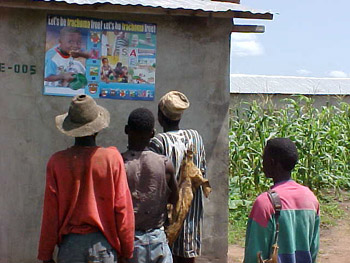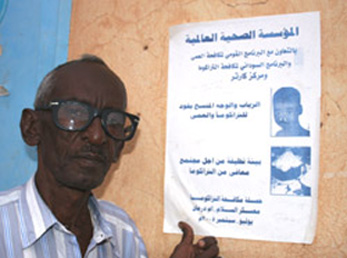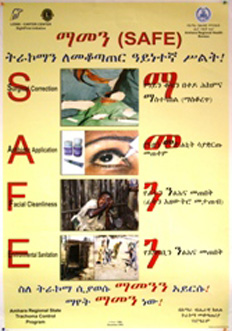Click here to view the gallery of posters

All photos: Carter Center
Ghanaian men learn about face washing from a poster at a school.

Large size posters (left) such as this one in Addis Ababa can be used in urban settings to promote behavior change.
Overview
Trachoma control programs develop posters to supplement community health education activities. Posters serve as permanent reminders of trachoma control lessons when they are displayed outside public spaces such as schools, health clinics, community meeting areas, and government agencies. Trachoma programs have had success with posters that include local language and pictures or images that illustrate the message in the text.
For non-literate populations, the pictures and images on posters are very important. The poster can be an effective form of health education if the images are culturally relevant to the target audience. To be sure that the messages are understandable, program managers should field-test posters before they distribute them. Many diagrams or figures that might appear obvious to a literate person, such as maps, are not always clear to a person without formal education. If your audience has a low rate of literacy, it is important to consider these factors when designing posters and other health education materials.
Designing a Poster
Posters should convey one simple, clear message. Use vocabulary from the audience's local language, and avoid being too technical. Use familiar images and simple illustrations. Images, colors, and symbols should be appropriate and logically organized. Text and illustrations should be balanced. Use a typestyle or font that can be read from a distance of at least two meters. Design posters with ample white space for easy readability.
Keep target groups in mind when displaying posters. Posters have the potential to reach a large audience, but there is benefit to displaying posters in less public spaces if the target group is hard to reach. For example, a female health worker might give posters to women to hang in their homes. Their female visitors, who may not spend much time in public spaces, will thus also have access to the health education.
 |
A Sudanese health worker poses in front of a trachoma poster. Notice the balance between images and text. |

Ethiopian S.A.F.E poster.

Posters displayed outside an Ethiopian health center feature different aspects of the SAFE strategy.

A Nigerian health worker displays his flip chart and poster before conducting health education.
Pre-Testing Posters
Posters must be pre-tested to ensure their cultural relevance. Organizations that support the development and production of health education materials often include their logo or name on the media. While posters draw attention to health problems in the community, they also allow an organization to receive more exposure. Be sure to pre-test materials before production as poor or inappropriate poster design can harm your organization's credibility.
Present the picture or illustration used in the poster to a sample of the target audience and ask:
After pre-testing the images, ask the audience to review the text. Observe how easy or difficult it is for people to read it. Test comprehension and ask them to explain the message in their own words. Ask them if there are any words that are hard to understand, and verify the text is legible. Most importantly, make sure the text and images are culturally appropriate.
If the target audience is hesitant to provide feedback, ask them to compare two different posters that have similar themes. Ask them to identify the most appealing elements from each poster. Find out which poster generates the most comment and feedback from the audience.
Do not worry if a poster requires several major changes until it is finalized. It is better to go through the process of development, editing, testing, re-development, and re-testing than spend money on a campaign that will ultimately fail.
View the Health Education Materials Tutorial to learn more about the design and development of health education materials.
View Posters (Click blue link to view full documents in PDF)
 |
 |
 |
 |
|
Ethiopia
Amharic |
Ethiopia
English, Amharic |
Ghana
English |
Sudan
English, Arabic |
 |
 |
 |
 |
|
Sudan
English, Arabic |
Sudan
English, Arabic |
Sudan
English |
South Sudan
English |
 |
 |
 |
 |
|
South Sudan
English |
Niger
English, Hausa |
Niger
French |
Nigeria
English |
 |
 |
 |
 |
|
Nigeria
Hausa |
Nigeria
English |
Nigeria
English |
Nigeria
English |
 |
 |
 |
 |
|
Vietnam
Vietnamese |
Vietnam
Vietnamese |
Vietnam
Vietnamese |
Vietnam
Vietnamese |
 |
 |
 |
 |
|
Vietnam
Vietnamese |
ICEH
English |
ICEH
English |
ICEH
English |
 |
|||
|
ICEH
English |
Please sign up below for important news about the work of The Carter Center and special event invitations.